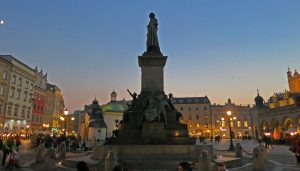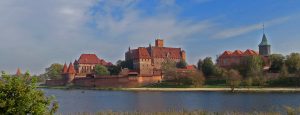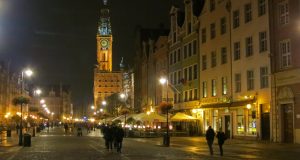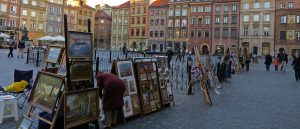 For some, a trip to Poland is an opportunity to reconnect with their Polish roots, a chance, perhaps, to sample some of their grandmother’s pierogies in their natural setting. Others are attracted to the unique beauty of Kraków, which has rightfully joined Prague and Budapest as part of the trinity of must-sees in central Europe. Still others are drawn by Poland’s dramatic and often tragic history. The absolute horrors of World War II, followed by the decades of Communist rule, have etched painful and moving monuments in the landscape. No country, with the possible exception of Russia, suffered as much as Poland during World War II. Millions of Poles, and nearly the entire prewar Jewish population of 1.2 million, were killed in fighting or in concentration camps. The deeply affecting and sobering thoughts on seeing the camps at Auschwitz and Birkenau, near Kraków, will last a lifetime. Nearly equally moving are the stories of the Lódz and Warsaw Jewish ghettos, or the story of the Warsaw uprising of 1944, when the city’s residents rose up courageously and futilely against their Nazi oppressors.
For some, a trip to Poland is an opportunity to reconnect with their Polish roots, a chance, perhaps, to sample some of their grandmother’s pierogies in their natural setting. Others are attracted to the unique beauty of Kraków, which has rightfully joined Prague and Budapest as part of the trinity of must-sees in central Europe. Still others are drawn by Poland’s dramatic and often tragic history. The absolute horrors of World War II, followed by the decades of Communist rule, have etched painful and moving monuments in the landscape. No country, with the possible exception of Russia, suffered as much as Poland during World War II. Millions of Poles, and nearly the entire prewar Jewish population of 1.2 million, were killed in fighting or in concentration camps. The deeply affecting and sobering thoughts on seeing the camps at Auschwitz and Birkenau, near Kraków, will last a lifetime. Nearly equally moving are the stories of the Lódz and Warsaw Jewish ghettos, or the story of the Warsaw uprising of 1944, when the city’s residents rose up courageously and futilely against their Nazi oppressors.
There are many uplifting moments of history, too. In Gdansk, you can visit the shipyards where Lech Waesa and his Solidarity trade union first rose to power to oppose Poland’s Communist government  in 1980. It was the rise of Solidarity that helped to bring down Communism in Poland, and arguably sparked the revolutions that swept the region in 1989.
in 1980. It was the rise of Solidarity that helped to bring down Communism in Poland, and arguably sparked the revolutions that swept the region in 1989.
And Poland is not only history. To the south, below Kraków, rise the majestic High Tatras, one of Europe’s most starkly beautiful ranges. To the north, the Baltic seacoast, with its pristine beaches, stretches for miles. The northeast is covered with lakes that run to the borderlands with Lithuania and Belarus. In the east of the country, you’ll find patches of some Europe’s last-remaining primeval forest, and a small existing herd of indigenous bison that once covered large parts of the Continent.
Warsaw, Poland’s capital city — not often included on many tourist itineraries — deserves a fresh look. While it will never have the charm of Kraków or Gdansk, there’s a spirit of rebirth here that’s immediately contagious. Some 85% of the city was destroyed during World War II, and nearly everything you see, including the charming and very “old” looking Old Town (Stare Miasto), has been around only for a few decades. The Old Town was faithfully rebuilt, brick by brick, in the aftermath of the war, according to paintings, photographs, architectural sketches, and personal memories. The reconstruction  was so good that in 1980 UNESCO included the Old Town on its list of World Cultural Heritage sites.
was so good that in 1980 UNESCO included the Old Town on its list of World Cultural Heritage sites.
Warsaw started life as a relatively small river town in the 14th century, but within a century it had become the capital city of the Duchy of Mazovia, ruling over small fiefdoms in central Poland. The city’s fortunes steadily improved in the 16th century after the duchy was incorporated into the Polish crown and Poland formed a union with Lithuania. The union greatly expanded the amount of territory under Polish influence. In 1596, King Sigismund III decided to move the capital to Warsaw from Kraków, mainly because it was easier for noblemen to travel to more centrally situated Warsaw. The subsequent centuries brought the usual mix of prosperity and disaster; the Swedes sacked the city in the 17th century, but in spite of it all Warsaw continued to grow wealthier.
Things went reasonably well for a time until World War II, when the city — like the rest of the country — was plunged into a modern-day Dante’s Inferno. The Nazis occupied the city in 1939 and held it for nearly the entire course of the war. The occupation was brutal; thousands of Warsaw residents were imprisoned or killed. Initially, it was the Jews who bore the brunt. The Nazis herded the city’s entire Jewish population of about 300,000, as well as around 100,000 Jews from elsewhere around Poland, into a small ghetto area west of the Old Town. Nearly all of them eventually lost their lives to sickness, starvation, or — mainly — the gas chambers at Treblinka. In 1943, the Jews heroically rose up against their oppressors in the first of two wartime Warsaw uprisings. The uprising was quickly put down and what remained of the ghetto was completely destroyed.
A year later, in 1944, with the war going badly for the Germans, the Polish resistance fighters, the Home Army, called for a general uprising against the German occupiers. For weeks in August and September of that year, Warsaw residents fought pitched battles with the Germans throughout the city, initially recording some heroic victories. Part of the plan was to enlist the assistance of the approaching Soviet Red Army, who had advanced to the Warsaw suburb of Praga across the river. That assistance never came, and the Germans eventually crushed the uprising. Hitler was so enraged that he ordered the remaining population expelled and the city razed to the ground. By the end of the war, 85% of Warsaw lay in ruins, and two out of every three residents — nearly 900,000 people — had died or were missing.
ordered the remaining population expelled and the city razed to the ground. By the end of the war, 85% of Warsaw lay in ruins, and two out of every three residents — nearly 900,000 people — had died or were missing.
The postwar years were bleak ones. Poland was cut off from Marshall Plan aid and the bulk of the reconstruction assistance initially came from the Soviet Union. With so much of the city destroyed, the Soviet-inspired planners could start from scratch. They widened the avenues to the proportions you see today and filled them with drab “Socialist-Realist”-style offices and apartment blocks. To be fair, some of these buildings aren’t so awful. The area around the Plac Konstytucji, in particular, has some handsome postwar buildings. And of course the unmissable Palace of Culture and Science is the granddaddy of them all. It’s a strictly love-it-or-hate-it affair, with many city residents falling squarely into the latter camp.
One notable exception to the postwar reconstruction was the Old Town. Instead of rebuilding it in modern Socialist style, Warsaw residents overwhelmingly chose to reconstruct exactly what they had lost. It’s a moving story of reclaiming identity from history, and the results are phenomenal.
Since the fall of Communism, the city’s fortunes have improved immensely. Warsaw, as the capital city, has grabbed more than its share of the country’s newfound wealth and the city skyline is looking more and more like a sun-belt boomtown every day. The changes are every bit as dramatic on the cultural front. New clubs, theaters, performance spaces, and restaurants have opened their doors, and the city feels more vital now than it has in many, many decades.
Kraków, the capital of the Polish region of Malopolska, is one of the most beautiful cities in central Europe and a highlight on any tour of the region. The city escaped serious damage during World War II and its only real regional rival for pure drop-dead beauty is the Czech capital, Prague. The formal perfection of its enormous central square, the Rynek Gówny, as well as the charm of the surrounding streets and Wawel Castle have always been known to Poles.
Kraków’s precise origins are unclear, but the city first rose to prominence at the turn of the first millennium as a thriving market town. The enormous size of the Rynek attests to Kraków’s early importance, even if its exact origins are unknown. One story about Kraków’s founding has it that a poor man named “Krak” started the whole thing by slaying a dragon that was ravaging the early inhabitants. Krak allegedly felled the beast by filling an animal carcass with sulfur (or lye) and tricking the beast to eat it. Naturally, so the story goes, he was awarded great wealth and a city, “Krak-ów,” named after him.
But frankly, I’m a bit skeptical. The city of Brno, in the Czech Republic, has a similar myth about its early days. And it’s hard to imagine there were that many beasts running around, as well as clever men with bags of sulfur on hand to the job. What is clear is that by the time of the early Piast dynasty in the 11th century, Kraków was booming, and Wawel Hill, with its commanding view of the Vistula River, was a natural setting for a capital.
As befitting any medieval city, Kraków had its ups and downs. In the 13th century, the city was razed to the ground by the central Asian Tartars, but was quickly rebuilt (and parts remain remarkably unchanged to this day). Kraków’s heyday was arguably the mid-14th century when King Kazimierz the Great commissioned many of the city’s finest buildings and established Jagellonian University, the second university to be founded in central Europe after Prague’s Charles University. For more than 5 centuries, Kraków served as the seat of the Polish kingdom (it only lost out to the usurper Warsaw in 1596 after the union with Lithuania made the Polish-Lithuanian kingdom so large that it became difficult for distant noblemen to travel here).
Kraków started to decline around this time. Following the Polish partitions at the end of the 18th century, Kraków eventually fell under the domination of Austria-Hungary, and was ruled from Vienna. It became the main city in the new Austrian province of Galicia, but had to share some of the administrative duties with the eastern city of Lwów (which must have quite a climb down for a former Polish capital!).
Viennese rule proved to be a boon in its own right. The Habsburgs were far more liberal in their views than either the Prussians or czarist Russia, and the relative tolerance here fostered a Polish cultural renaissance that lasted well into the 20th century. Kraków was the base of the late-19th and early-20th-century Moda Polska (Young Poland) movement, a revival of literature, art, and architecture (often likened to “Art Nouveau”) that is still fondly remembered to this day.
Kraków had traditionally been viewed as a haven for Jews ever since the 14th century when King Kazimierz first opened Poland to Jewish settlement. The Kraków district named for the king, Kazimierz, began life as a separate Polish town, but through the centuries slowly acquired the characteristics of a traditional Jewish quarter.
World War II drastically altered the city and for all intents and purposes ended this Jewish cultural legacy. The Nazis made Kraków the nominal capital of their rump Polish state: the “General Gouvernement.” The Nazi governor, and later war criminal, Hans Frank, ruled brutally from atop Wawel Castle. One of the first Nazi atrocities was to arrest and eventually execute the Polish faculty of Jagellonian University. Not long after the start of the war, the Nazis expelled the Jews from Kazimierz, first placing them in a confined ghetto space at Podgórze, about a mile south of Kazimierz, and later deporting nearly all of them to death camps. (As a historical aside: Frank was prosecuted at the Nuremburg trials and executed in 1946.)
Kraków luckily escaped destruction at the end of the war, but fared poorly in the postwar decades under the Communist leadership. The Communists never liked the city, probably because of its royal roots and intellectual and Catholic pretensions. For whatever reason they decided to place their biggest postwar industrial project, the enormous Nowa Huta steelworks, just a couple of miles upwind from the Old Town.
Kraków will be forever linked with its most famous favorite son, Pope John Paul II. The pope, Karol Woytya, was born not far from Kraków, in the town of Wadowice, and rose up through the church hierarchy here, serving for many years as the archbishop of the Kraków diocese before being elevated to pope in 1978. If Gdansk and the Solidarity trade union provided the industrial might of the anti-Communist movement, then Kraków and Pope John Paul II were the movement’s spiritual heart. The pope’s landmark trip to Poland in 1979, shortly after being elected pontiff, ignited a long-dormant Polish spirit and united the country in opposition to the Soviet-imposed government.
Kraków’s charms are multidimensional. In addition to the beautifully restored Old Town, complete with its fairy-tale castle, there’s the former Jewish quarter of Kazimierz. If you’ve seen Steven Spielberg’s Oscar-winning movie Schindler’s List, you’ll recognize many of the film locations as you walk around Kazimierz. For anyone unfamiliar with the film (or the book on which it was based, Thomas Keneally’s Schindler’s Ark), Oskar Schindler was a German industrialist who operated an enamel factory during World War II. By employing Jews from the nearby ghetto, he managed to spare the lives of 1,100 people who otherwise would have gone to the death camps at Auschwitz.
Outside of central Kraków, there are several trips that merit a few hours or a full day of sightseeing. The most important of these is the former Nazi extermination camp at Auschwitz-Birkenau (in the town of Oswiecim, about 81km/50 miles to the west of the city). Also recommended is a trip to the unusual and unforgettable Wieliczka salt mines.